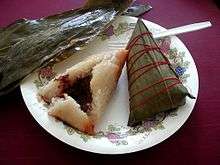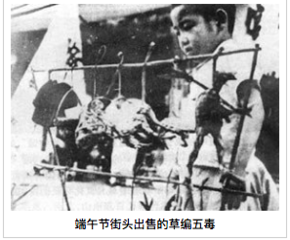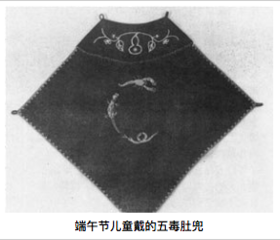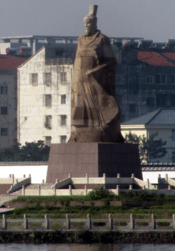Dragon Boat Festival
The Dragon Boat Festival is a traditional holiday which occurs on the 5th day of the 5th month of the traditional Chinese calendar.
| 端午節 Dragon Boat Festival | |
|---|---|
 Dragon Boat Festival (18th century) | |
| Observed by | Chinese |
| Type | Cultural |
| Observances | Dragon boat racing, consumption of realgar wine and zongzi |
| Date | 5th day of the 5th lunar month |
| 2019 date | 7 June |
| 2020 date | 25 June |
| 2021 date | 14 June |
| 2022 date | 3 June |
| Frequency | annual |
| Related to | Tango no sekku, Dano, Tết Đoan Ngọ, Yukka Nu Hii |
| Chinese name | |||||||||||||||||||||||||||
|---|---|---|---|---|---|---|---|---|---|---|---|---|---|---|---|---|---|---|---|---|---|---|---|---|---|---|---|
| Simplified Chinese | 端午节 | ||||||||||||||||||||||||||
| Traditional Chinese | 端午節 | ||||||||||||||||||||||||||
| Literal meaning | "The very mid point of the year Festival" | ||||||||||||||||||||||||||
| |||||||||||||||||||||||||||
| Dragon Boat Festival | |||||||||||||||||||||||||||
| Simplified Chinese | 龙船节 / 龙舟节 | ||||||||||||||||||||||||||
| Traditional Chinese | 龍船節 / 龍舟節 | ||||||||||||||||||||||||||
| |||||||||||||||||||||||||||
| Double Fifth Festival Fifth Month Festival Fifth Day Festival | |||||||||||||||||||||||||||
| Simplified Chinese | 重五节 / 双五节 五月节 五日节 | ||||||||||||||||||||||||||
| Traditional Chinese | 重五節 / 雙五節 五月節 五日節 | ||||||||||||||||||||||||||
| |||||||||||||||||||||||||||
| Dumpling Festival | |||||||||||||||||||||||||||
| Simplified Chinese | 肉粽节 | ||||||||||||||||||||||||||
| Traditional Chinese | 肉糭節 | ||||||||||||||||||||||||||
| Literal meaning | Meat Zongzi Festival | ||||||||||||||||||||||||||
| |||||||||||||||||||||||||||
| Portuguese name | |||||||||||||||||||||||||||
| Portuguese | Festividade do Barco-Dragão | ||||||||||||||||||||||||||
The Chinese calendar is lunisolar, so the date of the festival varies from year to year on the Gregorian calendar. In 2017, it occurred on 30 May; in 2018, on 18 June; in 2019, on 7 June; and in 2020, on 25 June.
Names
The English language name for the holiday is Dragon Boat Festival,[1] used as the official English translation of the holiday by the People's Republic of China.[2] It is also referred to in some English sources as Double Fifth Festival which alludes to the date as in the original Chinese name.[3]
Chinese names by region
Duanwu (Chinese: 端午; pinyin: duanwu), as the festival is called in Mandarin Chinese, literally means "starting/opening horse", i.e., the first "horse day" (according to the Chinese zodiac/Chinese calendar system) to occur on the month;[4][lower-alpha 1] however, despite the literal meaning being wǔ, "the [day of the] horse in the animal cycle", this character has also been interchangeably construed as wǔ (traditional Chinese: 伍; simplified Chinese: 五; pinyin: duanwu) meaning "five". Hence Duanwu, the "festival on the fifth day of the fifth month".[7]
The Mandarin Chinese name of the festival is "端午節" (simplified Chinese: 端午节; traditional Chinese: 端午節; pinyin: Duānwǔjié; Wade–Giles: Tuan Wu chieh)[lower-alpha 2] on the mainland and Taiwan,[8][6][9] and "Tuen Ng Festival" for Hong Kong, Macao,[10] Malaysia and Singapore.[11]
It is pronounced variously in different Chinese dialects. In Cantonese, it is romanized as Tuen1 Ng5 Jit3 on Hong Kong and Tung1 Ng5 Jit3 on Macao. Hence the "Tuen Ng Festival" in Hong Kong [11] Tun Ng (Festividade do Barco-Dragão in Portuguese) in Macao.[12][13]
History
Superstition
The fifth lunar month is considered an unlucky month. People believed that natural disasters and illnesses are common in the fifth month. In order to get rid of the misfortune, people would put calamus, Artemisia, pomegranate flowers, Chinese ixora and garlic above the doors on the fifth day of the fifth month.[14] Since the shape of calamus forms like a sword and with the strong smell of the garlic, it is believed that they can remove the evil spirits.


Another origin of Dragon Boat Festival: Before the Qin Dynasty (221-206 B.C.), the fifth month of the lunar calendar was regarded as a bad month and the fifth day of the month like a bad day, and known as the Dragon Boat festival nowadays. Poisonous animals will appear starting from this days such as snakes, centipedes, and scorpions as well as that people may get sick easily after this day. Therefore, during the Dragon Boat Festival, people try any way to avoid bad luck. For example, people paste pictures of the five poisonous creatures on the wall and stick needles in them. People also make paper cuttings of the five creatures and wrapped these around the wrists of their children.[15] Big ceremonies and performances developed from these practices in many areas, making the Dragon Boat Festival a day for getting rid of disease and bad luck.
Decorating doors by hanging wormwood and calamus plants is an important ritual of the Dragon Boat Festival. People believe that doing so will drive evil spirits and diseases away.
Qu Yuan
The story best known in modern China holds that the festival commemorates the death of the poet and minister Qu Yuan (c. 340–278 BC) of the ancient state of Chu during the Warring States period of the Zhou Dynasty.[16] A cadet member of the Chu royal house, Qu served in high offices. However, when the king decided to ally with the increasingly powerful state of Qin, Qu was banished for opposing the alliance and even accused of treason.[16] During his exile, Qu Yuan wrote a great deal of poetry. Twenty-eight years later, Qin captured Ying, the Chu capital. In despair, Qu Yuan died by suicide by drowning himself in the Miluo River.
It is said that the local people, who admired him, raced out in their boats to save him, or at least retrieve his body. This is said to have been the origin of dragon boat races. When his body could not be found, they dropped balls of sticky rice into the river so that the fish would eat them instead of Qu Yuan's body. This is said to be the origin of zongzi.[16]
During World War II, Qu Yuan began to be treated in a nationalist way as "China's first patriotic poet". The view of Qu's social idealism and unbending patriotism became canonical under the People's Republic of China after 1949 Communist victory in the Chinese Civil War.
Wu Zixu
Despite the modern popularity of the Qu Yuan origin theory, in the former territory of the Kingdom of Wu, the festival commemorated Wu Zixu (died 484 BC), the Premier of Wu. Xi Shi, a beautiful woman sent by King Goujian of the state of Yue, was much loved by King Fuchai of Wu. Wu Zixu, seeing the dangerous plot of Goujian, warned Fuchai, who became angry at this remark. Wu Zixu was forced to commit suicide by Fuchai, with his body thrown into the river on the fifth day of the fifth month. After his death, in places such as Suzhou, Wu Zixu is remembered during the Dragon Boat Festival.
Cao E
Although Wu Zixu is commemorated in southeast Jiangsu and Qu Yuan elsewhere in China, much of Northeastern Zhejiang including the cities of Shaoxing, Ningbo and Zhoushan celebrates the memory of the young girl Cao E (曹娥, AD 130–144) instead. Cao E's father Cao Xu (曹盱) was a shaman who presided over local ceremonies at Shangyu. In 143, while presiding over a ceremony commemorating Wu Zixu during the Dragon Boat Festival, Cao Xu accidentally fell into the Shun River. Cao E, in an act of filial piety, decided to find her father in the river, searching for 3 days trying to find him. After five days, she and her father were both found dead in the river from drowning. Eight years later, in 151, a temple was built in Shangyu dedicated to the memory of Cao E and her sacrifice for filial piety. The Shun River was renamed Cao'e River in her honor.[17]

Pre-existing holiday
Some modern research suggests that the stories of Qu Yuan or Wu Zixu were superimposed onto a pre-existing holiday tradition. The promotion of these stories might be encouraged by Confucian scholars, seeking to legitimize and strengthen their influence in China. The relationship between zongzi, Qu Yuan and the festival, first appeared during the early Han dynasty.[18]
The stories of both Qu Yuan and Wu Zixu were recorded in Sima Qian's Shiji, completed 187 and 393 years after the events, respectively, because historians wanted to praise both characters.
Another theory, advanced by Wen Yiduo, is that the Dragon Boat Festival originated from dragon worship. Support is drawn from two key traditions of the festival: the tradition of dragon boat racing and zongzi. The food may have originally represented an offering to the dragon king, while dragon boat racing naturally reflects a reverence for the dragon and the active yang energy associated with it. This was merged with the tradition of visiting friends and family on boats.
Another suggestion is that the festival celebrates a widespread feature of east Asian agrarian societies: the harvest of winter wheat. Offerings were regularly made to deities and spirits at such times: in the ancient Yue, dragon kings; in the ancient Chu, Qu Yuan; in the ancient Wu, Wu Zixu (as a river god); in ancient Korea, mountain gods (see Dano). As interactions between different regions increased, these similar festivals eventually merged into one holiday.
Early 20th Century
In the early 20th Century the Dragon Boat Festival was observed from the first to the fifth days of the fifth month, and also known as the Festival of Five Poisonous Insects (simplified Chinese: 毒虫节; traditional Chinese: 毒蟲節; pinyin: Dúchóng jié). Yu Der Ling writes in chapter 11 of her 1911 memoir "Two Years in the Forbidden City":
The first day of the fifth moon was a busy day for us all, as from the first to the fifth of the fifth moon was the festival of five poisonous insects, which I will explain later—also called the Dragon Boat Festival. [...] Now about this Feast. It is also called the Dragon Boat Feast. The fifth of the fifth moon at noon was the most poisonous hour for the poisonous insects, and reptiles such as frogs, lizards, snakes, hide in the mud, for that hour they are paralyzed. Some medical men search for them at that hour and place them in jars, and when they are dried, sometimes use them as medicine. Her Majesty told me this, so that day I went all over everywhere and dug into the ground, but found nothing.[19]
Public holiday

'恭祝總統端節愉快' ('Respectfully Wishing the President a Joyous Dragon Boat Festival')
The festival was long marked as a cultural festival in China and is a public holiday in the mainland, Hong Kong SAR, Macau SAR, and Taiwan (ROC). The People's Republic of China government established in 1949 did not initially recognize the Dragon Boat Festival as a public holiday but re-introduced it in 2008 alongside two other pre-Communist festivals in a bid to boost traditional culture.[20][21]
Dragon Boat Festival is unofficially observed by the Chinese communities of Southeast Asia, including Singapore and Malaysia. Equivalent and related official festivals include the Korean Dano, Japanese Children's Day, and Vietnamese Tết Đoan Ngọ.
Practices and activities
Three of the most widespread activities conducted during the Dragon Boat Festival are eating (and preparing) zongzi, drinking realgar wine, and racing dragon boats.[22]
Dragon boat racing
Dragon boat racing has a rich history of ancient ceremonial and ritualistic traditions, which originated in southern central China more than 2500 years ago. The legend starts with the story of Qu Yuan, who was a minister in one of the Warring State governments, Chu. He was slandered by jealous government officials and banished by the king. Out of disappointment in the Chu monarch, he drowned himself into the Miluo River. The common people rushed to the water and tried to recover his body. In commemoration of Qu Yuan, people hold dragon boat races yearly on the day of his death according to the legend. They also scattered rice into the water to feed the fish, to prevent them from eating Qu Yuan's body, which is one of the origins of zongzi.

Zongzi (Traditional Chinese Rice Dumpling)
A notable part of celebrating Dragon Boat Festival is making and eating zongzi with family members and friends. People traditionally wrap zongzi in leaves of reed, bamboo, forming a pyramid shape. The leaves also give a special aroma and flavor to the sticky rice and fillings. Choices of fillings vary depending on regions. Northern regions in China prefer sweet or dessert-styled zongzi, with bean paste, jujube, and nuts as fillings. Southern regions in China prefer savory zongzi, with a variety of fillings including marinated pork belly, sausage, and salted duck eggs.
The reason why the Chinese eat zongzi on this special day has many statements. The folk version is to hold a memorial ceremony for Quyuan. While in fact, Zongzi has been regarded as an oblation for the ancestor even before the Chunqiu period. From the Jin dynasty, Zongzi officially became the festival food and long last until now.
Food related to 5
'Wu' (午) in the name 'Duanwu' in Chinese has a similar pronunciation as the number 5 in multiple dialects, and thus many regions have traditions of eating food that is related to the number 5. For example, the Guangdong and Hong Kong regions have the tradition of having congee made from 5 different beans.
Realgar wine
Realgar wine or Xiong Huang wine is a Chinese alcoholic drink that is made from Chinese yellow wine dosed with powdered realgar, a yellow-orange arsenic sulfide mineral also known as "rice wine". It is often used as a pesticide against mosquitoes and other biting insects during the hot summers, and as a common antidote against poison in ancient Asia.
5-colored silk-threaded braid
In some regions of China, parents braid silk threads of 5 colors and put them on their children's wrists, on the day of the Dragon Boat Festival. People believe that this will help keep bad spirits and diseases away.
Other common activities include hanging up icons of Zhong Kui (a mythic guardian figure), hanging mugwort and calamus, taking long walks, and wearing perfumed medicine bags. Other traditional activities include a game of making an egg stand at noon (this "game" implies that if someone succeeds in making the egg stand at exactly 12:00 noon, that person will receive luck for the next year), and writing spells. All of these activities, together with the drinking of realgar wine or water, were regarded by the ancients and some today as effective in preventing disease or evil while promoting health and well-being.
In the early years of the Republic of China, Duanwu was celebrated as the "Poets' Day" due to Qu Yuan's status as China's first known poet. The Taiwanese also sometimes conflate the spring practice of egg-balancing with Duanwu.[23]
The sun is considered to be at its strongest around the time of summer solstice, as the daylight in the northern hemisphere is the longest. The sun, like the Chinese dragon, traditionally represents masculine energy, whereas the moon, like the phoenix, traditionally represents feminine energy. The summer solstice is considered the annual peak of male energy while the winter solstice, the longest night of the year, represents the annual peak of feminine energy. The masculine image of the dragon has thus associated with the Dragon Boat Festival.[24]
Gallery
 Hari in Tomigusuku, Okinawa, Japan.
Hari in Tomigusuku, Okinawa, Japan. Activities to avoid bad luck
Activities to avoid bad luck A bodice worn by kids with symbols of the Five Poisonous Insects on it to deter poisonous insects, and reptiles such as frogs, lizards, snakes.
A bodice worn by kids with symbols of the Five Poisonous Insects on it to deter poisonous insects, and reptiles such as frogs, lizards, snakes.- A dragon boat racing in San Francisco, 2008.
- Raw Rice Dumpling
See also
- Dano (Korean festival)
- Bon Om Touk
- Traditional Chinese holidays
Explanatory notes
References
- Citations
- Chittick (2011), p. 1.
- Chinese Government's Official Web Portal. "Holidays Archived May 2, 2012, at the Wayback Machine". 2012. Accessed 1 November 2013.
- "Double Fifth (Dragon Boat) Festival Archived May 6, 2008, at the Wayback Machine".
- Inahata, Kōichirō (2007). Tango 端午 (たんご). Heibonsha World Encyclopedia 世界大百科事典 (revised, new ed.). Heibonsha. via Japanknowledge.
- Lowe (1983), p. 141.
- "Dragon Boat Festival". Taiwan Today. Ministry of Foreign Affairs, Republic of China (Taiwan). 1 June 1967.
- Chen, Sanping (January–March 2016). Were ‘Ugly Slaves’ in Medieval China Really Ugly?. Journal of the American Oriental Society. 136. pp. 30–31. JSTOR 10.7817/jameroriesoci.136.1.117.CS1 maint: ref=harv (link)
- General Office of the State Council of the People's Republic of China. 《国务院办公厅关于2011年部分节假日安排的通知国办发明电〔2010〕40号》. 9 December 2010. Accessed 3 November 2013. (in Chinese)
- Ministry of Foreign Affairs, Republic of China (Taiwan). "Holidays and Festivals in Taiwan Archived 2014-02-21 at the Wayback Machine Archived 2014-02-16 at the Wayback Machine". Accessed 3 November 2013. (in Chinese and English).
- Special Administrative Region of Macao. Office of the Chief Executive. 《第60/2000號行政命令》. 3 October 2000. Accessed 3 November 2013. (in Chinese)
- GovHK. " General holidays for 2014". 2013. Accessed 1 November 2013.
- Macau Government Tourist Office. "Calendar of Events". 2013. Accessed 3 November 2013.
- Special Administrative Region of Macao. Office of the Chief Executive. "Ordem Executiva n.º 60/2000". 3 October 2000. Accessed 3 November 2013. (in Portuguese)
- "Photos of the Chinese Traditional Festivals - Dragon Boat Festival". Retrieved 4 March 2019.
- Liu, L. (2011). 'Beijing Review' Color Photographs. vol. 54, issue 23. pp. 42–43.CS1 maint: location (link)
- SCMP." Earthquake and floods make for the muted festival. Retrieved on 9 June 2008. Archived 25 June 2012 at the Wayback Machine
- "The river in which she jumped was renamed as Cao's River". Archived from the original on 4 April 2017.
- "The Legends Behind the Dragon Boat Festival". Smithsonian. 14 May 2009.
- Yü, Der Ling (1911). Two Years in the Forbidden City. T. F. Unwin. Project Gutenberg
- People's Daily. "Peopledaily." China to revive traditional festivals to boost traditional culture. Retrieved on 9 June 2008.
- Xinhua Net. "First day-off for China's Dragon Boat Festival helps revive tradition Archived 2013-12-22 at the Wayback Machine." Xinhua News Agency. Published 8 June 2008. Retrieved on 2008-06-09.
- "Dragon Boat Festival". China Internet Information Center. Retrieved on 12 June 2013.
- Huang, Ottavia. Hmmm, This Is What I Think: "Dragon Boat Festival: Time to Balance an Egg". 24 June 2012. Accessed 3 November 2013.
- Chan, Arlene & al. Paddles Up! Dragon Boat Racing in Canada, p. 27. Dundurn Press Ltd., 2009. ISBN 978-1-55488-395-0. Accessed 1 June 2011.
- Bibliography
- Chittick, Andrew (2011). "The Song Navy and the Invention of Dragon Boat Racing". Journal of Song-Yuan Studies. 2011 (41): 1–28. JSTOR 23496206.CS1 maint: ref=harv (link)
- Lowe, H. Y. (aka Lü Hsing-yüan 慮興源) (2014) [1983]. "The Dragon Boat Festival". The Adventures of Wu: The Life Cycle of a Peking Man. Translated by Bodde, Derk. Princeton University Press. pp. 141–148. JSTOR j.ctt7ztjmr.20.

